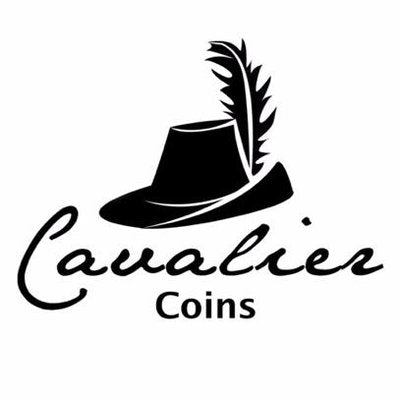Have you ever held two old coins, seemingly identical, and wondered why one might be worth a small fortune while the other is just loose change? Figuring out the value of a coin collection is about much more than just age. It's a fascinating blend of rarity, physical condition, and sheer collector demand.
What Really Drives a Coin's Value?
Think of it like assessing a classic car. The year it was made is a great starting point, but its true worth comes from a combination of three key pillars: how many were originally produced, how well it's been looked after, and how many people want to own it today. Getting to grips with these fundamentals is your first step towards looking at your collection with a more experienced eye.
These three factors—Rarity, Condition, and Demand—are in a constant dance, working together to determine a coin's final market price. A coin might be incredibly rare, but if it's in terrible shape or nobody is actively collecting that series, its value will struggle to take off. On the flip side, a relatively common coin in pristine condition can command a surprisingly high price if it's on every collector's wish list.
The Three Pillars of Coin Valuation
A good analogy is to picture a three-legged stool. If one leg is shorter or weaker than the others, the stool isn't very stable. It's the same with a coin; it needs to be strong in all three areas to reach its full potential value.
- Rarity: This isn't just about the original mintage—the number of coins struck by the mint. It’s also about the survival rate. How many of those coins are thought to still exist in a collectable condition today? Many were lost or melted down over the years.
- Condition (Grade): The physical state of the coin is absolutely crucial. A coin that boasts sharp, clear details and its original mint lustre will always be far more valuable than a heavily worn or damaged counterpart.
- Demand: This is the market's "X factor". Is the coin part of a popular set that everyone's trying to complete? Is there a sudden wave of interest in coins from a particular monarch or historical period?
This image perfectly illustrates how these core elements come together.
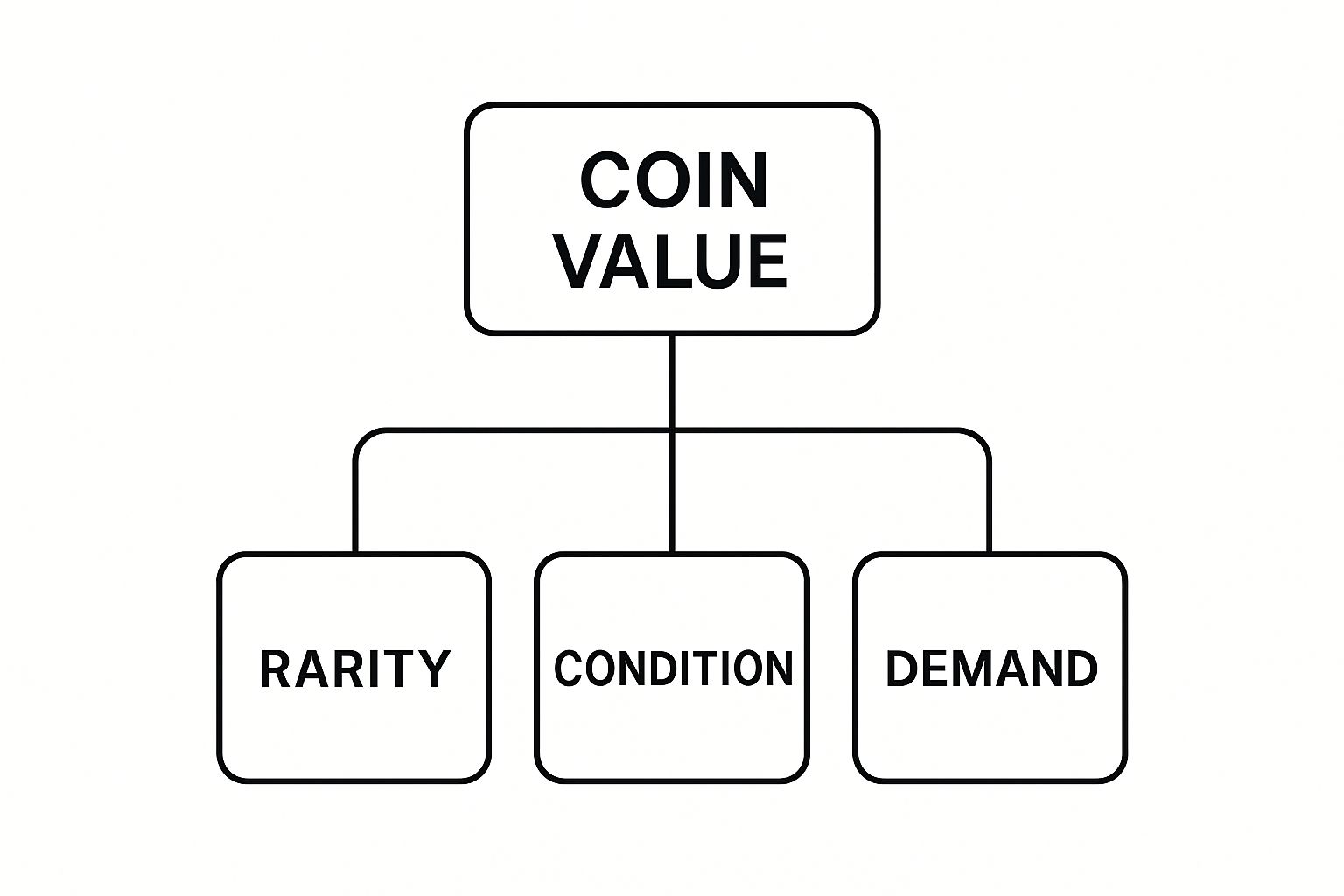
As you can see, it's the interplay between a coin's rarity, its preservation, and current collector interest that ultimately establishes its worth.
To help you keep these concepts straight, here's a quick reference table.
Quick Guide to Coin Value Factors
This table breaks down the primary drivers of a coin's value, helping you quickly understand the most important concepts.
| Factor | What It Means | Impact on Value |
|---|---|---|
| Rarity | The number of coins originally minted and how many are still available to collectors. | The fewer there are, the higher the potential value. Very high impact. |
| Condition (Grade) | The physical state of the coin, from worn and damaged to perfectly preserved. | A coin in pristine, "uncirculated" condition is worth significantly more. Critical impact. |
| Demand | How many collectors are actively trying to acquire this specific coin. | High demand from a large collector base can drive prices up, even for common coins. |
Understanding these factors is the key to recognising why some coins are more sought-after than others.
How These Factors Interact in Practice
This isn't just theory; it has a real, measurable impact on what coins sell for. Take British Victorian coins, for instance. An 1848 farthing in "choice uncirculated" condition could be valued at around £900. Yet, an 1851 farthing in "extremely fine" condition—just a couple of grades lower—might only fetch about £370. The difference is stark. You can discover more about historical British coin values to see more detailed examples of how condition affects price.
Key Takeaway: A coin's value isn't a fixed number set in stone. It’s a dynamic figure that rises and falls based on a delicate balance between its scarcity, its state of preservation, and its popularity with other collectors. Mastering these ideas is the foundation of becoming a savvy collector.
How Rarity and Mintage Create Value
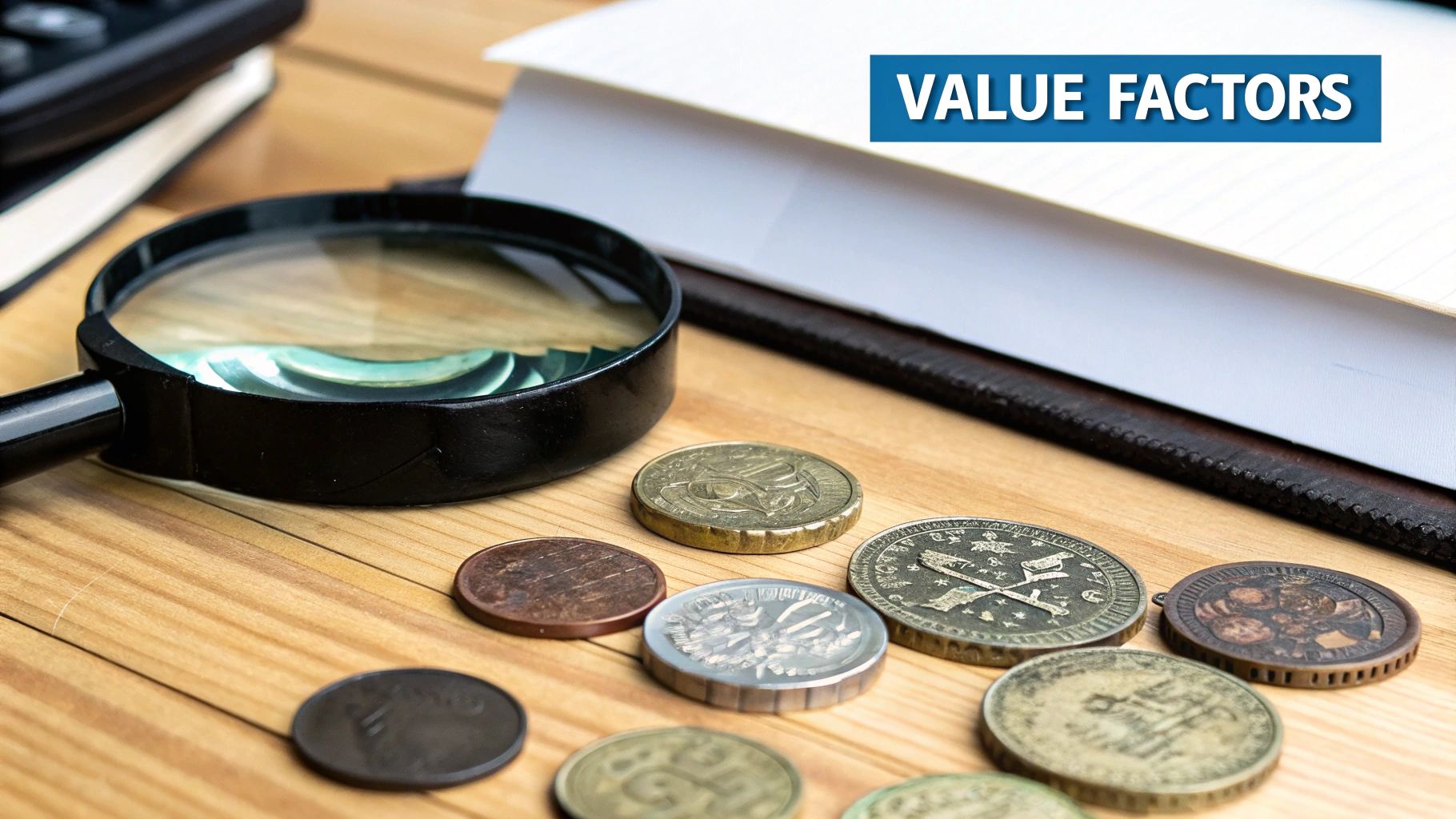
Rarity is probably the biggest factor driving a coin's price tag, but figuring out what makes a coin truly scarce is more of an art than a science. Many newcomers think age equals rarity, but that's a classic mistake. While plenty of old coins are hard to find, true rarity comes down to a numbers game.
You really need to get to grips with two key ideas. First is mintage—that’s simply how many coins of a particular design were originally struck by the mint in a specific year. But the second, and often more crucial factor, is the survival rate. This is the best guess at how many of those coins are still around today in a decent, collectable state.
Mintage Versus Survival Rate
Let's use an analogy. Think of a limited-edition art print versus a mass-produced poster from the 1970s. The art print has a tiny, declared print run, so its mintage is low right from the start. The poster, on the other hand, might have been printed in the millions. But how many of those posters survived the decades without being torn, taped to a wall, or thrown out? Probably not many.
A coin's story is much the same. A mint might produce millions of a certain coin, but events like war, economic collapse, or official government recalls could lead to the vast majority being melted down for their metal. This can slash the number of surviving examples, turning a once-common coin into an unexpected treasure. It's why a coin struck during a short, chaotic reign is often rarer than one from a long, peaceful era—fewer were made, and even fewer were saved.
Key Insight: A low original mintage is a great starting point, but the real secret to value is often a low survival rate. A coin that was pocket change in its day but is nearly impossible to find now can be worth a fortune.
How Mint Errors Create Instant Rarity
Sometimes, rarity isn't planned at all—it's just a happy accident. A mint error is a mistake that happens right at the source, during the coin's manufacturing process. These aren't scratches or dings that happened later; they are flaws that were literally pressed into the coin as it was made.
These little imperfections can turn an otherwise ordinary coin into a collector's dream. Some of the classic errors to look for include:
- Off-centre strikes: The design isn't lined up properly on the metal blank.
- Double strikes: The coin gets stamped more than once, creating a ghostly, overlapping image.
- Wrong planchet: A design is struck on a blank intended for a completely different coin (e.g., a 10p design on a 2p blank).
- Mules: A very rare and famous error where the obverse ('heads') die and reverse ('tails') die from two different coins are mistakenly paired together.
Even a modern coin can become a superstar because of a specific error. Take the 2015 United Kingdom 2 pence coin. Millions were made, but certain rare mint errors on one in extra fine condition have seen estimated values climb to between $85,000 and $90,000. It's a perfect example of how one small slip-up at the mint can create enormous value.
Identifying True Scarcity
Learning to spot genuine rarity is what separates the casual collector from a seasoned numismatist. It takes a bit of detective work and a good eye. Mintage figures are a great place to start, as they are often publicly available.
But to truly understand survival rates, you need to dig deeper. This means looking at auction records and population reports from professional grading services. These reports track how many examples of a coin have been officially graded, giving you a much clearer picture of how many high-quality specimens are known to exist.
At the end of the day, the rarest coins are the ones that are tough to find even when you have the cash ready. If you're intrigued by what elevates a coin to legendary status, you'll enjoy our guide on the most valuable coins in the world.
Grading Your Coins Like a Professional
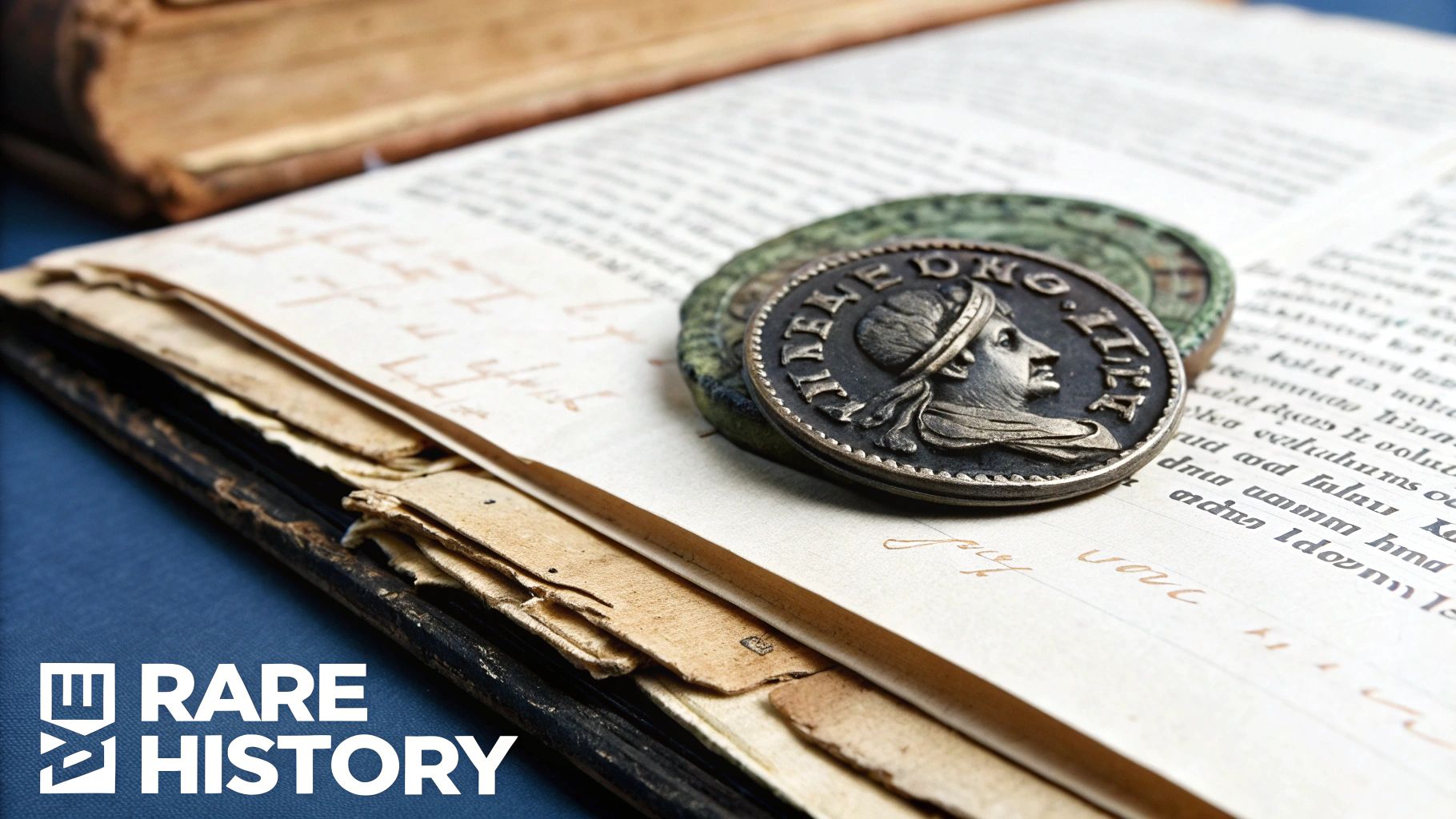
While a coin's rarity sets its potential, its physical condition—what we call its grade—is often what truly defines its market value. It might sound surprising, but a common coin that has been perfectly preserved can easily be worth more than a very rare one that’s seen better days. The grade is one of the most critical factors in determining what a collection is actually worth.
Think of it like collecting first-edition books. A pristine hardback, still in its original dust jacket, is worlds apart in value from a tattered, dog-eared copy of the same title. The story inside is identical, but the condition makes all the difference. Coins are no different.
Getting a handle on how to assess a coin's condition is a fundamental skill for any collector. It gives you the power to make an educated first guess about your collection’s quality and potential worth before you bring in a professional.
The Foundation of UK Coin Grading
In the UK, we use a descriptive grading system. It's a straightforward way of assessing how much wear and tear a coin has suffered since the day it was minted. The scale runs all the way from a coin that is barely identifiable to one that looks like it was just struck.
Every step up this ladder represents a significant jump in quality and, almost always, in value. Even a subtle shift, like moving from "Extremely Fine" to "About Uncirculated," can sometimes double a coin's price tag.
Let’s start at the bottom. The grades of Poor (P) and Fair (F) are for coins that have been heavily worn down by their time in circulation. A coin graded as Poor might only show the basic outline and date, with most of its intricate details smoothed away. A Fair coin is a small step up, with the main design visible but still very worn.
Moving up the scale, we find Good (G) and Very Good (VG). A "Good" coin will have most of its design and lettering visible, though they'll be quite flat. "Very Good" shows a bit more definition, but the highest points of the design are still worn completely flat.
The Grades Where Value Truly Builds
The real excitement and significant jumps in value begin once you get into the higher grades. This is where signs of circulation become minimal, and it's what serious collectors are hunting for, especially when it comes to rarer issues.
Here are the key levels you need to know:
- Fine (F): Shows moderate wear on the high points, but all the main details are clear. You can expect to see about half of the finer details, like the strands of hair in a monarch's portrait.
- Very Fine (VF): The wear here is light, really only on the very highest points of the design. Much more of the original detail is present, giving the coin a really pleasing look.
- Extremely Fine (EF or XF): Now we're talking. The coin has only the slightest traces of wear, often only noticeable under a magnifying glass. It still has most of its original surface quality and shine.
- About Uncirculated (AU): A coin that saw almost no circulation. It might have a tiny hint of wear on the absolute highest points or a few minor scuffs from being in a mint bag, but to the naked eye, it looks nearly new.
Key Insight: Telling these higher grades apart can be tricky. It often comes down to looking at the very highest points of a coin's design—a monarch's cheekbone, the top of a crown, or the highest feathers on a bird—for that first tell-tale sign of friction. For a more detailed look with pictures, it's worth reviewing a complete expert guide to UK coin grading to see what each stage really looks like.
The Pinnacle of Preservation: Uncirculated and Proof
At the very top of the scale are the coins that have never been used as money. These are the crown jewels for collectors, showcasing the artist's original vision in its purest form.
Uncirculated (UNC), sometimes called Mint State (MS), means a coin with absolutely no wear. It looks just as it did on the day it left the mint. It might have some small "bag marks" from bumping against other coins during production, but it has never been spent.
Even more special is Proof (PF). A Proof isn't actually a grade but a special method of manufacturing. These coins are struck multiple times with highly polished dies on hand-prepared coin blanks. The result is breathtaking: a coin with a stunning, mirror-like background and a frosted, razor-sharp design. They are produced specifically for collectors and represent the highest quality possible.
Understanding UK Coin Grading Standards
To help you get started, here's a quick reference table breaking down the most common grading terms you'll encounter. It’s a simplified look, but it covers the essentials for sorting and assessing your coins.
| Grade | Abbreviation | Description of Wear |
|---|---|---|
| Proof | PF | A special minting process; sharp details and a mirror-like finish. Not intended for circulation. |
| Uncirculated | UNC | No trace of wear. May have bag marks but has never been used as money. |
| Extremely Fine | EF / XF | Very light wear on only the highest points of the design. Most original lustre is present. |
| Very Fine | VF | Light to moderate wear on high points, but all major details are sharp. |
| Fine | F | Moderate, even wear across the surface, but the design is clear and bold. |
| Good | G | Heavily worn, but the main design and lettering are still visible. |
By getting comfortable with these grades, you can begin to sort your collection by quality. This is a crucial first step toward truly understanding its overall value and potential.
The Hidden Value in a Coin's History
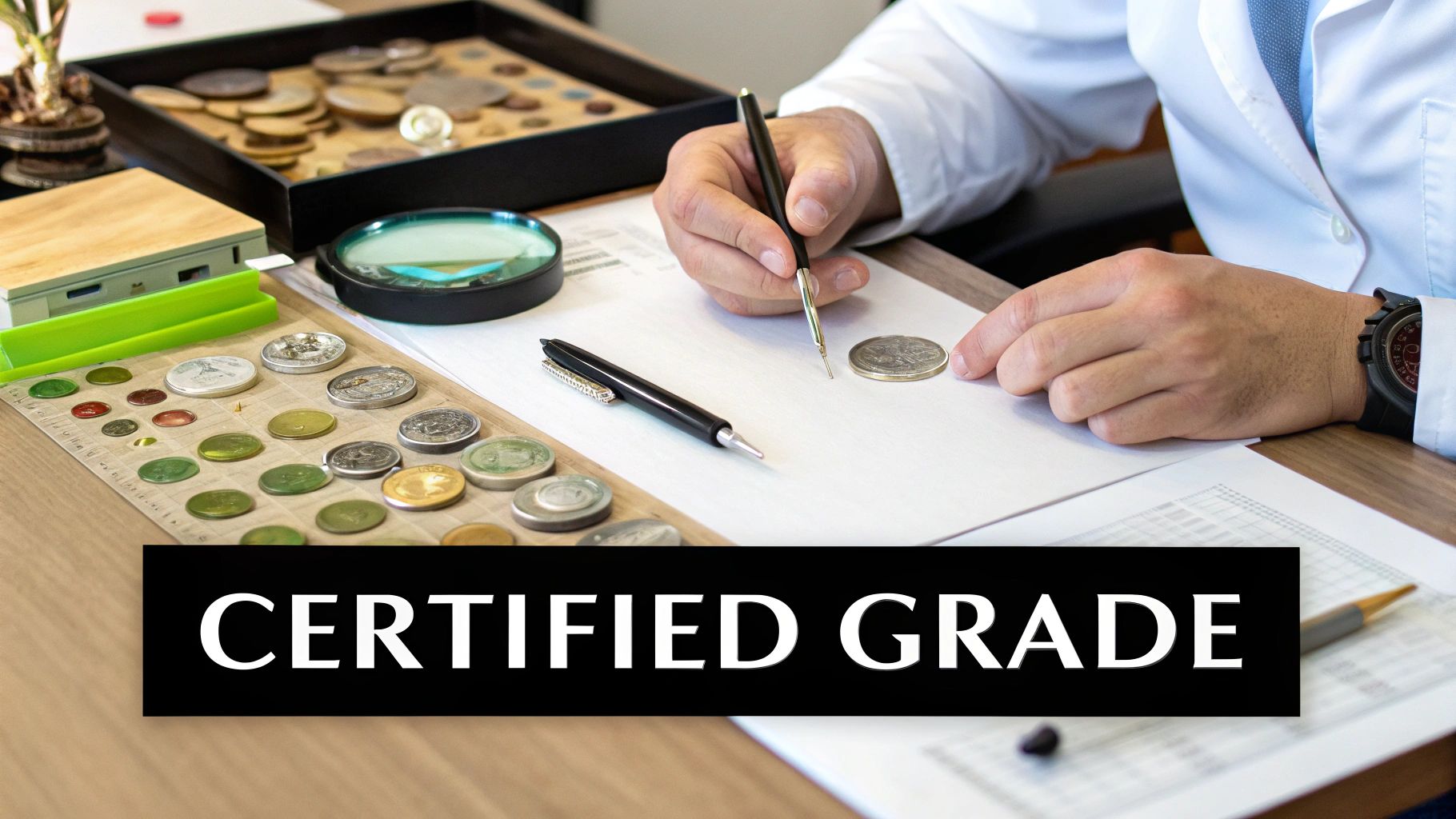
Beyond the cold, hard facts of rarity and grade lies something far more romantic, a factor that can dramatically increase the value of a coin collection: its story. Sometimes, a coin’s connection to the past is every bit as important as the metal it was struck from. When you think about it, collectors aren't just buying a small disc of metal; they’re acquiring a tangible piece of history they can hold in their hands.
This story-driven value really comes from two places: a coin's historical significance and its ownership history, which we call provenance. A coin minted during a pivotal moment—say, the declaration of a war, the reign of a controversial monarch, or a period of great discovery—carries an emotional weight that fascinates collectors. And that fascination often translates directly into higher monetary worth.
Just imagine holding a coin that could have been in the pocket of a soldier at the Battle of Waterloo. That direct link to such a famous event gives it a character and appeal that a more common coin from a peaceful era simply can't match.
The Power of Historical Significance
A coin's backstory can elevate its status from a simple collectable to a true historical artefact. The key is its association with a specific, well-known event or person. It’s this connection that adds a layer of depth collectors are often very willing to pay a premium for.
You can see how history shapes value in a few classic scenarios:
- Political Upheaval: Coins struck by a king who only reigned for a few months before being overthrown offer a window into a turbulent time. Edward VIII coins are a perfect British example. His abdication in 1936 meant virtually no official currency with his portrait ever entered circulation, making the few patterns that exist incredibly valuable.
- Wartime Issues: Emergency money, like coins made from unusual metals during a siege or occupation, tells a powerful story of survival and necessity. They are quite literally physical relics of hardship and resilience.
- Pivotal Reigns: Coins from the start of a new dynasty or the end of an old one mark clear turning points in history. A coin from the reign of Queen Anne, for instance, who oversaw the unification of England and Scotland to form Great Britain, is more than just currency; it’s a symbol of a new national identity.
A coin is a snapshot of the society that created it. It reflects the art, politics, and economic realities of its time. When you buy a historically significant coin, you are buying a direct link to that moment.
This historical context provides a narrative that makes a collection far more engaging and, in many cases, far more valuable.
Understanding the Importance of Provenance
While historical significance is all about a coin's origin, provenance is about its life story after it was made—its documented chain of ownership. It’s much like a famous painting once owned by a Rockefeller; a coin that was part of a legendary collection carries extra prestige.
Think of provenance as a coin's CV. A strong provenance confirms a coin's authenticity and often means it has been off the market for a long time, which only increases its desirability. If you can trace a coin back to the collection of a famous aristocrat, a respected numismatist, or even royalty, its value can soar.
For example, a Roman coin is interesting on its own. But a Roman coin that was part of the renowned collection of the 18th-century Earl of Pembroke? That's in another league entirely. The earl's name adds a layer of glamour and authenticity. This documented history gives buyers confidence and a unique story they can pass on to the next owner, enhancing the overall value of the coin collection.
Understanding Market Trends and Collector Demand
A coin collection's value isn't set in stone. It’s a living thing, constantly shifting with the market's mood. Much like fine art or vintage cars, the world of numismatics has its own economic rhythm, a pulse driven by supply, demand, and the ever-changing tastes of collectors. Getting a handle on these dynamics is what separates someone who just accumulates coins from a savvy collector who knows exactly when to buy, sell, or hold.
You can almost think of it as a "stock market" for coins. A coin that everyone is chasing today might cool off in a few years, while a once-overlooked series could suddenly become the next big thing. To really grasp what your collection is worth, you need to look past the metal and understand the people who want to own it.
Why Collector Demand Is the Driving Force
Demand is the engine that truly powers the coin market. It’s simple economics: when a huge number of collectors are all after the same coins, prices are bound to go up. We see this all the time with series that are popular to collect as a full set, like the modern commemorative 50p coins. That powerful urge to "complete the set" creates a steady, reliable demand for every single piece in the series.
So, what causes these trends to catch on? It can be almost anything, really.
- Pop Culture: A blockbuster film or a hit TV show set in a certain historical period can suddenly make coins from that era incredibly popular.
- Anniversaries: Big historical milestones often spark a wave of new interest in the coinage connected to them.
- New Discoveries: Sometimes, news of a newly found mint error or a rare variety gets out, sending collectors everywhere scrambling to check their own jars of change.
Thanks to online auction sites, this market is more transparent than ever. You can watch in real-time what coins are actually selling for, giving you a much more immediate picture of demand than a once-a-year price guide ever could.
Key Takeaway: A coin’s rarity and condition determine its potential value, but it’s the active demand from collectors that sets its current market price. Keeping an eye on what's hot is essential for any realistic valuation.
How to Keep Up with Numismatic Trends
So, how do you stay on top of it all? One of the best ways is to simply pay attention to recent auction results. What are people actively bidding on right now? Are prices for Victorian-era sovereigns on the rise, or has the focus shifted to modern bullion coins like the Britannia?
This is a market that has shown impressive growth, which points to a strong and expanding base of collectors. In fact, data from the UK shows the rare coin market grew from approximately £1.18 million in 2002 to over £4.13 million by 2012. That’s a huge leap in just a decade, and it shows just how powerful sustained collector interest can be. You can dive deeper into these figures and the factors behind them in this detailed analysis of the UK rare coin market.
It’s smart to keep one eye on the timeless classics and the other on modern collectables. While iconic coins like gold sovereigns have a stable, long-term appeal, modern releases like Royal Mint commemorative sets can see their prices swing wildly based on mintage numbers and immediate buzz. Watching both gives you a much fuller picture of the market’s health and where it might be heading next.
The New Age of Market Access
Not too long ago, the coin market felt like a bit of a closed shop, mainly run by specialist dealers and old-school auction houses. The internet has completely changed the game. This newfound accessibility means more people are getting into the hobby, which in turn creates more demand for a wider range of coins.
This ease of buying and selling online has created a much more dynamic and liquid market. Trends can catch on faster than ever, and collectors now have instant access to pricing data. This all helps you build a more grounded, realistic view of your collection—seeing it not just as a fascinating hobby, but as a tangible asset whose value is shaped by real-world economic forces.
How to Find Accurate Coin Valuations
Knowing what makes a coin valuable is one half of the puzzle. The other, often trickier part, is figuring out how to find reliable, up-to-date pricing information. The secret isn't finding one magic source; it's about looking at several different ones to build a truly accurate picture of what your collection is worth.
Think of it like getting a second opinion from a doctor. One source might give you a solid baseline, but by combining insights from printed books, online databases, and actual recent sales, you get a much more realistic and confident valuation. This approach helps you avoid the common trap of either overvaluing or undervaluing your coins.
Essential Printed Price Guides
For anyone serious about collecting British coins, some books are simply non-negotiable. The gold standard is Spink’s 'Coins of England & the United Kingdom' catalogue. It's often called the "bible" for UK numismatists for good reason, providing incredibly detailed listings and estimated values for almost every British coin you can imagine, across all grades.
Its real strength is how comprehensive it is, backed by decades of expertise. But remember, it’s a physical book printed once a year, so the prices can sometimes lag behind a rapidly changing market. Use it as your bedrock, your foundation, but always cross-reference it with more current sources.
Reputable Online Resources
For a more immediate pulse on the market, online resources are absolutely essential. Pricing websites and databases often pull together data from countless dealers and recent auction results, giving you a much more dynamic view of a coin's current value.
Stick to well-established websites that focus on UK coinage. They offer a huge amount of information, but always be savvy about where that information comes from. A dealer's website might list a retail "asking price," which is very different from what a coin has actually sold for. It’s a small but critical distinction when you’re trying to pin down true market value.
Expert Tip: Before you trust an online price, check when the guide was last updated. A price from two or three years ago is ancient history in the coin world; it's not a reflection of today's market. Look for sites that show consistent, recent updates—that's the mark of a reliable resource.
Tracking Recent Auction Results
The most honest reflection of what a coin is worth right now is what someone has just paid for it. This is where websites like eBay are incredibly useful. Don't just look at what's for sale; filter your search to see "sold" items. This shows you the real-world transaction prices for coins just like yours, in a similar condition.
Pay close attention to the quality of the photos and how the seller described the coin, as these details massively affect the final price. This method gives you raw, unfiltered market data, showing what real buyers are actually willing to spend. For a deeper dive into these techniques, take a look at our complete guide on expert coin collection valuation tips for UK coins.
When to Seek a Professional Appraisal
Doing your own research with these resources is fantastic, but sometimes you just need a professional's eye. If you believe you have a particularly rare coin, own a large and valuable collection, or simply need a definitive valuation for insurance or a potential sale, it’s time to call in an expert.
A reputable dealer or an accredited appraiser can offer a formal, written valuation. They have the years of experience needed to spot the subtle details that can make all the difference, and their market knowledge is second to none. This gives you the confidence and peace of mind you need to decide on your next steps.
Common Questions on Coin Valuation
It's only natural to have questions when you're trying to figure out what a coin collection is worth. It can feel like a complex puzzle. To help you piece it all together, here are some straightforward answers to the questions we hear most often from collectors.
What’s the Single Most Important Factor for a Coin's Value?
While several things have to line up, condition (or grade) is usually the kingmaker. It might seem odd, but a common coin in pristine, untouched condition can easily fetch more than a very rare coin that's been heavily battered and worn. Always start by looking at the coin's physical state – that's the baseline for its entire value.
Should I Clean My Coins to Make Them Look Better?
In a word: no. This is perhaps the costliest mistake a new collector can make. Cleaning a coin, no matter how gently you think you're doing it, strips away its original surface and destroys the natural toning, or patina, that builds up over decades. This one act can slash a coin's value by 90% or even more.
A Quick Word of Advice: Serious collectors value originality above all else. Any polishing, scrubbing, or chemical cleaning is immediately obvious to an expert eye and is a huge red flag in the market. Leave the history and character on the coin.
How Much Is My Old Coin Collection Worth?
That’s the million-pound question, isn't it? There's no one-size-fits-all answer because it completely depends on what's inside. A jar full of common, circulated modern coins might just be worth its face value. On the other hand, a carefully curated collection with just a handful of rare, high-grade coins could be worth thousands.
To get a rough idea yourself, you'll need to do a bit of detective work:
- Identify the date and mint mark on each coin.
- Assess its condition as honestly as you can, using the grading standards we've covered.
- Research what similar coins have recently sold for.
Where’s the Best Place to Sell My Coins?
It really depends on what you have. For lower to mid-value coins, online auction sites give you access to a huge audience of buyers. But if you have truly high-value, rare coins or an entire specialised collection, your best bet is to speak with a reputable dealer or a specialist auction house. They have the expertise to grade your coins properly and know how to reach serious collectors willing to pay a premium.
Whether you're just starting, looking to grow your collection, or want to understand what you're holding, Cavalier Coins Ltd has the expertise to help. We invite you to explore our wide range of rare and collectable pieces from all over the world. Visit Cavalier Coins and you might just find your next treasure.
